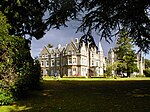Air Forces Memorial
Buildings and structures on the River ThamesCommonwealth War Graves Commission memorialsGrade II* listed buildings in SurreyMonuments and memorials in SurreyRoyal Air Force memorials ... and 1 more
World War II memorials in England

The Air Forces Memorial, or Runnymede Memorial, in Englefield Green, near Egham, Surrey, England is a memorial dedicated to some 20,456 men and women from air forces of the British Empire who were lost in air and other operations during World War II. Those recorded have no known grave anywhere in the world, and many were lost without trace. The name of each of these airmen and airwomen is engraved into the stone walls of the memorial, according to country and squadron.
Excerpt from the Wikipedia article Air Forces Memorial (License: CC BY-SA 3.0, Authors, Images).Air Forces Memorial
Cooper's Hill Lane, Borough of Runnymede
Geographical coordinates (GPS) Address External links Nearby Places Show on map
Geographical coordinates (GPS)
| Latitude | Longitude |
|---|---|
| N 51.4378 ° | E -0.565 ° |
Address
Air Forces Memorial
Cooper's Hill Lane
TW20 0LG Borough of Runnymede
England, United Kingdom
Open on Google Maps








